Restaurant-style Sichuan hot pot soup base has a super rich aroma and tastes like the ones you’d get in China. The finished base is a thick paste that can be portioned out easily and it’s freezer friendly, making it a perfect edible holiday gift. {Vegan, Gluten-Free Adaptable}
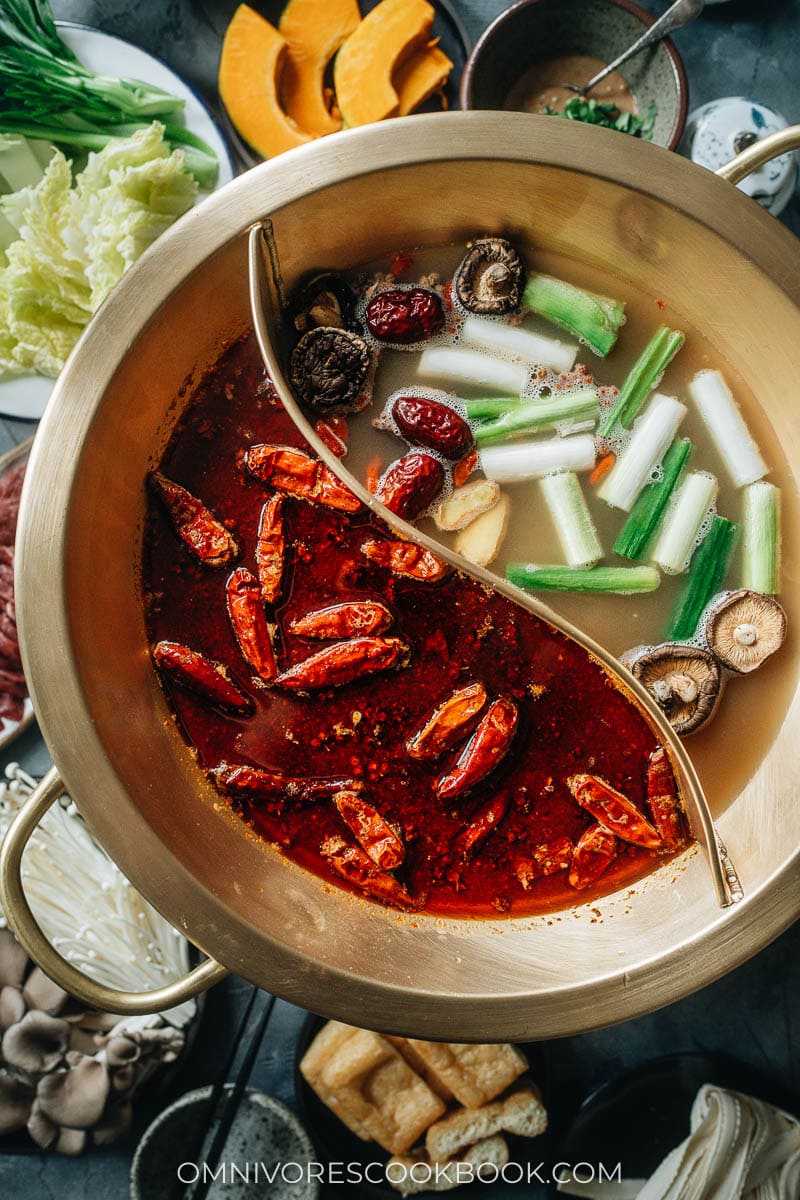
Now that weather is finally getting cooler, it’s the perfect season for hot pot. After I published The Ultimate Hot Pot Guide, I received many positive reviews and got numerous requests for homemade Sichuan hot pot soup base. I have to admit, hot pot soup base is not something we make at home back in China, because it’s so easy to buy the packaged ones. I also thought the store bought ones always tasted better, because they are usually made by famous restaurants and stores that have hundreds of years of history.
But after we looked into it and did several tests, we realized that making Sichuan hot pot soup base at home is not complicated at all. And the taste is just as delicious (maybe even better) than the store-bought ones. Even better, the homemade version does not contain preservatives.
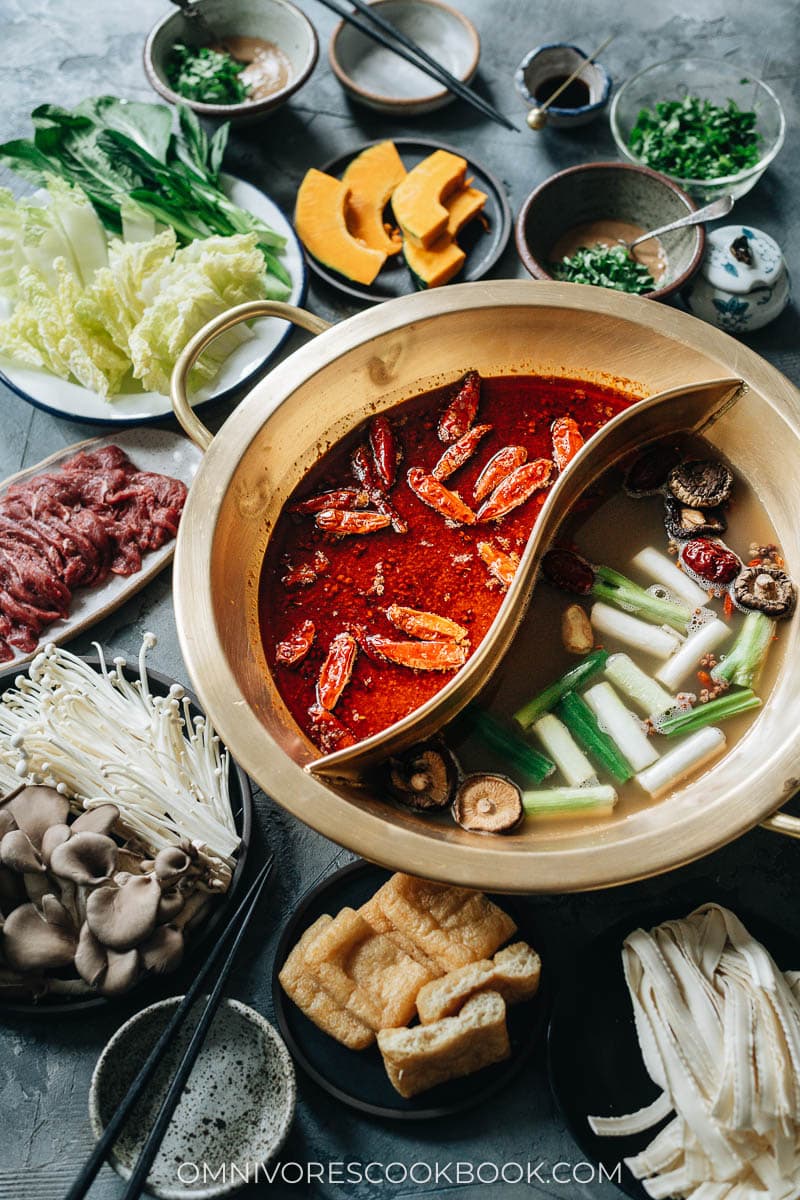
Why this recipe
- Maximum flavor, it makes a very rich and thick hot pot soup that is super fragrant, just like the ones at hot pot restaurants.
- It’s vegan. But if you wish to further boost the taste, you can replace some vegetable oil with tallow to make it even more luxurious.
- The soup base forms a thick paste once chilled, so you can portion it out and store for future use.
- To use the hot pot soup base, you simply need to dilute it with some broth and heat it up.
- The cooking only takes 15 minutes once you gather the ingredients.
Granted, it’s actually not that cheap to make Sichuan hot pot base at home if you have to buy every single ingredient. But if you’ve been making my Sichuan recipes, your pantry probably has everything needed for this recipe. Also, if you have high quality Sichuan peppercorns and dried chili peppers, your soup base will taste so much fresher and more delicious without using tons of salt and MSG (which are usually the main ingredients in packaged hot pot soup base).
Ingredients
As you can see in the picture below, the ingredient list is quite long but most of the ingredients are pantry basics. I highly recommend you use whole spices (cumin seeds, cloves, etc.), instead of ground spices, to maximize the taste. However, if you do not have certain whole spices, you can use ground ones as well.
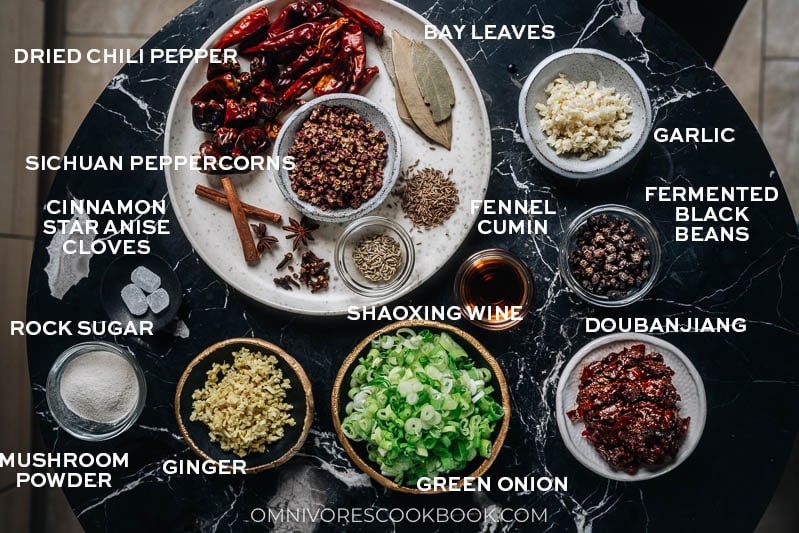
Sichuan peppercorns
Sichuan peppercorns are one of the main ingredients and it’s crucial that you use the freshest ones you can find. They add a rich aroma and numbing tingling sensation. If you’re not familiar with them, read this post for more information. I highly recommend the Sichuan peppercorns from The Mala Market. They’re imported directly from Sichuan and are some of the best I can find in the US.
Dried chili peppers
It’s best to use Chinese dried chili peppers because they are not overly spicy. I used a combination of Facing Heaven Chili Peppers and Lantern Chili Peppers, but it’s totally OK to use just one type.
If you cannot find Chinese dried chili peppers, you can use Korean dried chili peppers instead. They have a similar taste and are sometimes easier to find.
Doubanjiang
Another main ingredient that gives the soup base a spicy kick and rich fermented umami. The Pixian brand is the best and you can find it on Amazon. The traditional doubanjiang is a dark brown paste. If you use doubanjiang from a Japanese brand or US brand, it might be closer to a saucy texture and the taste will be less rich. I highly recommend you use the traditional doubanjiang, if possible, to get the best taste.
Oil
Sichuan hot pot soup base usually uses rapeseed oil. If you cannot find it, grapeseed oil, canola oil, or another neutral oil will work.
If you prefer an even richer and more intense taste, you can swap one cup of oil with a cup of tallow (beef fat). This makes for more of a Chongqing-style hot pot and is super delicious.

Cooking process
Cooking Sichuan hot pot base is super easy once you’ve gathered all the ingredients.
- Grind the spices
- Cook the aromatics in oil
- Dissolve the doubanjiang and fermented black beans. Add spice mix and cook for 10 minutes
- Mix in the rest of the seasonings
- Let the sauce cool, then blend it
- Store the soup base in a container and refrigerate it
- Once it’s chilled, the soup base will become a solid block
- You can divide the soup base and store it in individual bags for future use
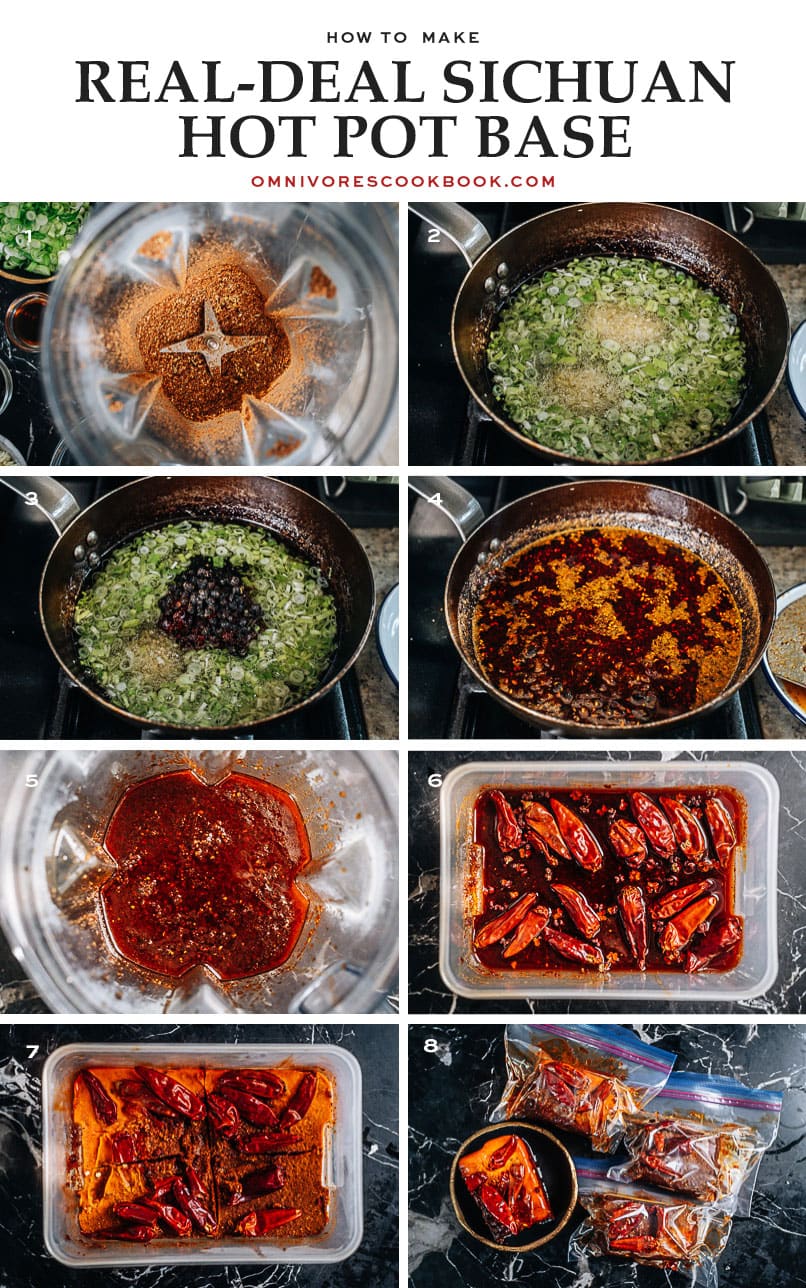
Extra chili peppers
I added some dried chili peppers to the finished hot pot base for garnish. If you eat spicy hot pot in a restaurant, they might use even more dried chili peppers in the soup. They will not add a lot of taste and are more for looks. You can add them or skip them.
Easy storage
Once you finish making the hot pot soup base, the spices will sink to the bottom and the oil will float on top. I found it’s best to chill the full batch and divide it later, so the spices will be evenly distributed to each block.
If you use some tallow in this recipe, the block will stay solid at room temperature and it might be easier to transport if you decide to give it as an edible gift.
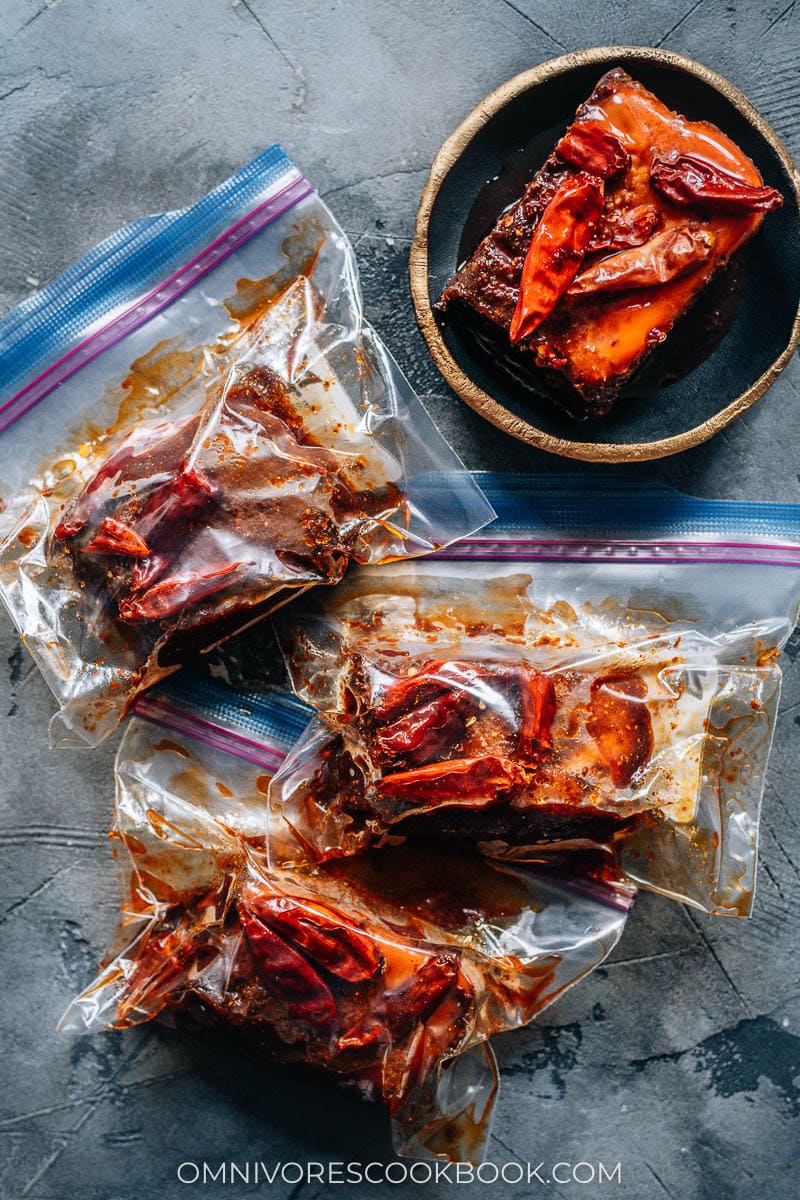
How to use the Sichuan hot pot soup base
No matter whether you’re using the refrigerated or frozen soup base, all you need to do is add it to the hot pot and add some broth to it. I prefer to use chicken broth, but you can use vegetable broth as well. Then bring the hot pot to a boil and mix the soup so the hot pot soup base dissolves completely. Then you’re ready to cook and eat!
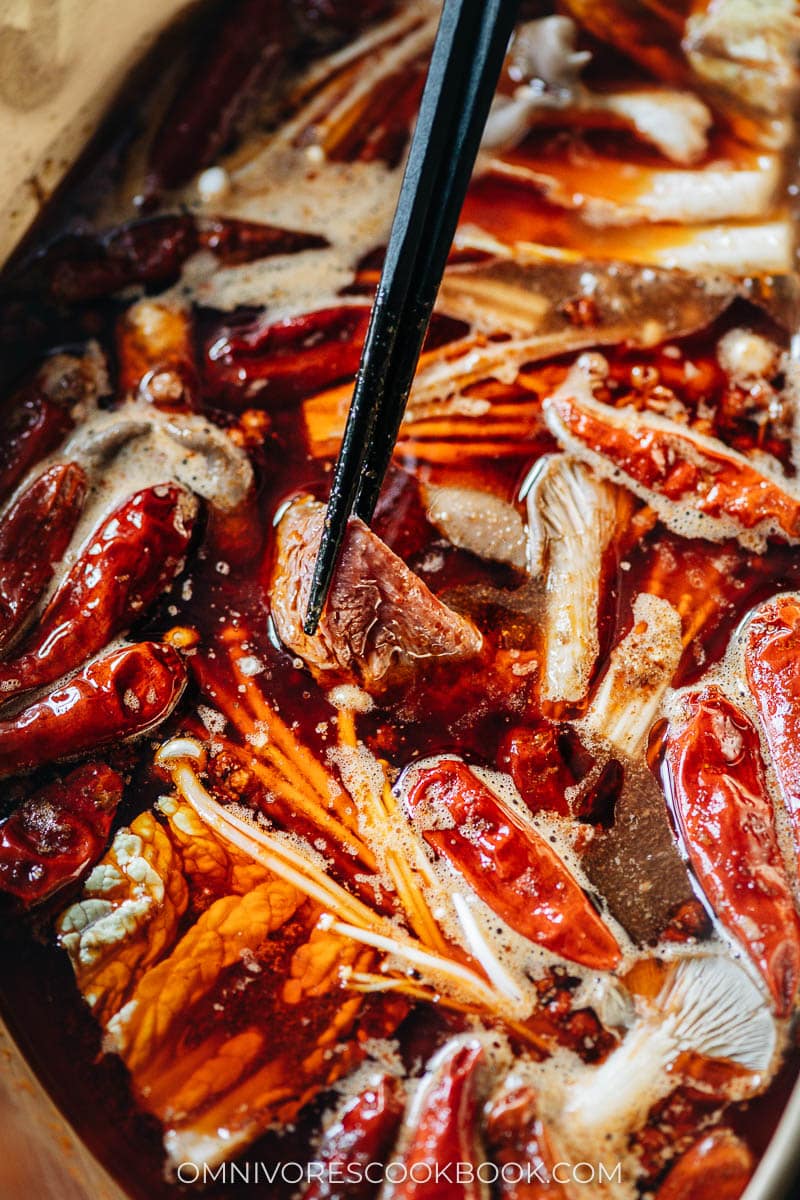
More information on hot pot
Want to learn more about Chinese Cooking? Sign up my newsletter to receive the 5-Day Chinese Cooking Crash Course and recipe update!
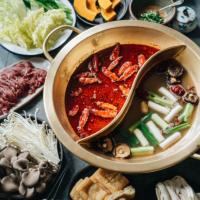
Sichuan Hot Pot Soup Base (川式清油火锅底料)
Ingredients
Spices
- 1/3 cup Sichuan peppercorns
- 1/2 cup dried chili peppers
- 2 cinnamon sticks
- 4 bay leaves
- 2 pods star anise
- 1 teaspoon cumin seeds
- 1 teaspoon fennel seeds
- 1/2 teaspoon cloves
Base
- 2 1/2 cups rapeseed oil (or other neutral oil) (*Footnote 1)
- 6 cloves garlic , chopped
- 4 ” (10 cm) ginger , chopped
- 4 to 6 green onions , chopped
- 1/2 cup Doubanjiang
- 3 tablespoons fermented black beans (or black bean paste/sauce)
- 1 teaspoon rock sugar (or white sugar)
- 1 tablespoon Shaoxing wine (or dry sherry)
- 3 tablespoons mushroom bouillon powder (or chicken bouillon powder)
- 12 dried chili peppers (for garnish) (*Footnote 2)
- 2 tablespoons Sichuan peppercorns , crushed (for garnish)
Instructions
- Combine all the spices in a blender or food processor. Mix until the spices turn into small flakes but not powdered.
- Heat the oil in a medium-sized pot or 9” deep pan over low heat until medium hot (if you add a small piece of garlic it should sizzle gently and not bubble furiously). Add the garlic, ginger, and green onion. Cook and stir until fragrant but not browned, about 2 minutes.
- Carefully add the doubanjiang and fermented black beans to the oil. Cook and stir for another minute.
- Add the blended spices. Cook, stirring frequently, for about 10 minutes. The oil should reach a vibrant orange-red color when it’s ready.
- Add the sugar, Shaoxing wine, and mushroom powder. Stir until dissolved.
- Remove the pan from the heat and let cool for 10 to 20 minutes (or longer if you have a non-heat proof blender).
- Add the cooled hot pot base mixture to the blender. Make sure the lid’s air vent is open. Start from a low speed, gradually raising to medium-high speed, blending until the oil is emulsified, about 1 minute. The mixture will look cloudy once blended.
- Carefully pour the hot pot soup base into a large heat proof tupperware. Top the whole dried chilis and crushed peppercorns evenly over the base for garnish. Cover the container and freeze overnight.
- Once frozen, you can divide the base into individual portions by slicing it into 4 pieces. Then you can store each piece in a ziplock bag in the freezer for up to 6 months. Each block is good for a small hot pot, or one side of a hot pot with a divider.
How to use the Sichuan hot pot soup base
- To use the hot pot base, add it to the hot pot and pour in 4 to 5 cups of broth (chicken or vegetable broth). Heat over medium-high heat and stir to dissolve the soup base. You’re ready to cook when the soup is boiling. Refer to my Ultimate Hot Pot Guide for more information on how to put together a hot pot dinner.
Notes
- You can swap out one cup of oil with a cup of tallow for a richer taste. It also allows the soup base block to congeal at room temperature.
- You can add more dried chili peppers for garnish if you want the look of a restaurant hot pot. It will not add too much spiciness to the soup base.
Nutrition
If you give this recipe a try, let us know! Leave a comment, rate it (once you’ve tried it), and take a picture and tag it @omnivorescookbook on Instagram! I’d love to see what you come up with.
More homemade sauces and ingredients
- Homemade XO Sauce (XO酱)
- Homemade Chili Garlic Sauce (Huy Fong Brand Copycat)
- Chinese BBQ Sauce (叉烧酱)
- Chinese Flavored Sweet Soy Sauce (复制酱油)
- How to Make Chili Oil (辣椒油)
Lilja Walter is a part of the Omnivore’s Cookbook team and worked closely with Maggie to develop and test this recipe.
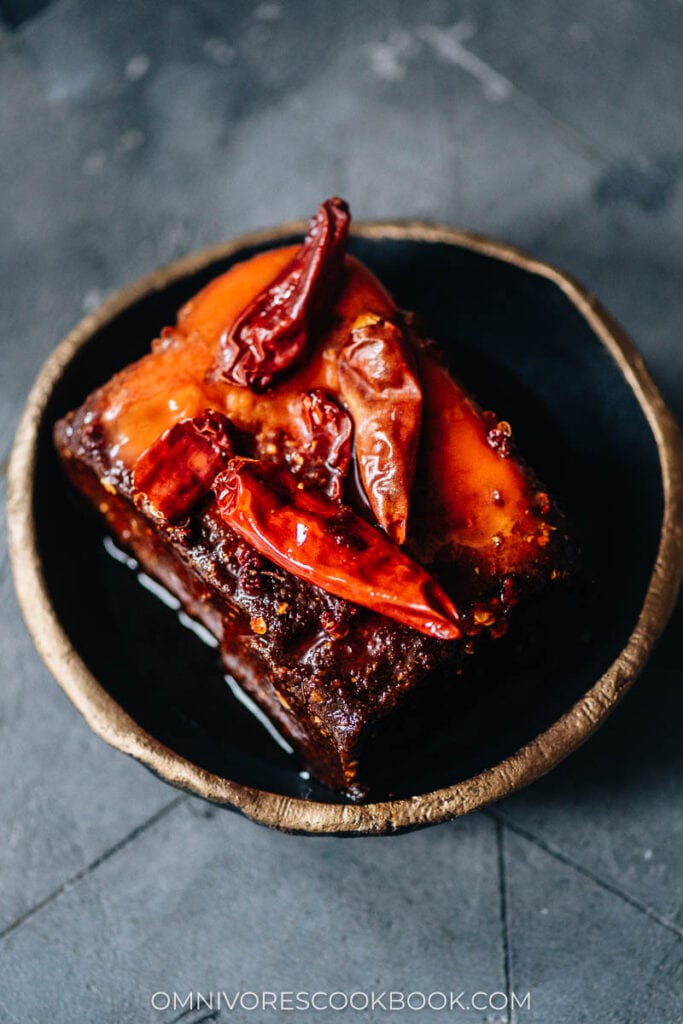
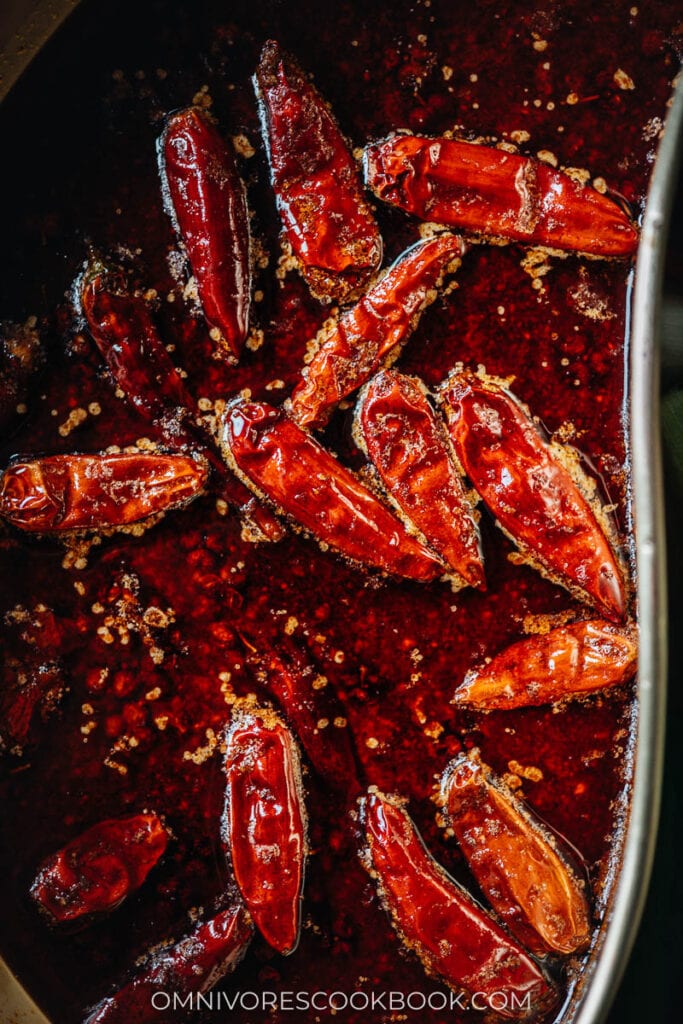














Could lao gan ma black bean chili sauce be used as a substitute for the fermented beans here? Also, is freezing it overnight necessary or could I use some if it the same day that I make it?
I think you can. It will slightly change the consistency of the sauce but shouldn’t be a big deal.
And yes you can use it the same day you make it.
The only reason of freezing is to easily divide them evenly (because the oil will be floating on top and it solidify after freezing).
Uh who’s pantry, someone who cooks Asian food a lot? Chinese cuisine junkies? I think the Average American attempting to cook might have Soy sauce someone who likes to explore cooking food in general might have more and I do but it’s rather broad and recipe specific ie miso, red chili paste, sake, mirin etc.. but yeah to make a comment like that is reckless. Unless your reader base is all Chinese and thats pretty narrow minded. Something like, Yes the ingredients are long but it’s worth it. I’d also add that unless you love it don’t try this recipe first try a prepackaged then if you love it buy it because homemade is so much better. If your readers don’t have that option and they go out and buy mung bean paste for a tablespoon worth 4.99 because they will never use the rest of the jar yeah I’d be upset. But hey I’m going to try it because I love anything Asian, wait nope baby ducks have grown in an egg , can’t do!
huh what are you talking about, Asian Food Lover? don’t call yourself an asian food lover if you don’t even have the ingredients, like seriously? I have all the ingredients except fennel seeds and I don’t even cook chinese food that much – but for real, Sichuan peppercorns, fermented black beans and shaoxing wine are a staple. Don’t come here calling the author giving reckless comment – appreciate author and people who are willing to test and share the recipe, it takes hard work and a lot of kindness, mind you.
I literally have every ingredient listed, and I am not Asian. Granted, cooking is a hobby so I’m probably better stocked than many, but I hardly think the author is being “reckless” .
it’s a recipe for a soup base. make it or don’t make it, you clearly have the time
Luckily most of the readers understand, what is meant by a phrase like that.
And yes, if someone cooks chinese recipes frequently, they have mostly everything they need already, like I do (average European person here)
So, just stop trolling, if if does not apply to your taste or stored ingridients, just scroll on??
I am a Latina from Hialeah, Florida and not only did I conveniently have ALL of the ingredients called for in the recipe – I also have the hot pot and induction plate for a traditional Chinese hot pot experience. No need to be Chinese to enjoy the flavorful, sophisticated, and fun hotpot experience!
I am sorry you were raised in a way that has lead you to believe that spreading unhappiness and anger is a way for you got get validation. That must be very difficult for you. Sharing food is an excellent way to move beyond trauma like that and form community among a diverse group who none the less share a common love of adventure in food. I hope that next time you think about lashing out with a comment like this you stop, breath, and choose to revel in the joy sites like this seek to share rather than lash out.
Wow. To be honest, I wasnt sure, if I would be able to recreate the great taste of restaurant hot-pot but I chose your recipe to try it. And then while I was making it and as soon as all the ingridients hit the oil, it was smelling like my favorite hotpot-place instantly! Like…it really smelled exactly like that! I was walking around in my kitchen and couldnt stop smiling. And then it tasted really just perfect. Sheer perfection. And I also think that it is quite easy to make, I had to buy only a few of the ingridients and most of the work was done by the blender. I will probably never buy storebought again and I am so much looking forward to the frozen portions of this.
Absolute recommendation!
We made this for a dinner party of 7 last night. It was fantastic! We had three hot pots boiling during dinner: mild, medium and HOLY HELL MALA!…this morning I swear my tongue is still tingly so you can guess which one I used! The only down side is that we pretty much used every dish in the house, which means that I will be spending my morning cleaning and doing dishes! But totally worth it. Our guests had never had hot pot and they LOVED it.
I have attempted to make my own soup base before but never came close to what you can get at the big hot pot chain restaurants like Hai Di Lao, and now I know why. My wife says that this base actually beats anything she has had at a hot pot restaurant, and that is high praise indeed considering that she grew up in China (I’m just a laowai)!
Thanks again Maggie for another winner!
Hi Maggie, I’m just wondering where the salt is coming in during the recipe because it doesn’t call for any at all. But whenever I do order out, it tends to be quite salty!
The salty taste comes from the Doubanjiang, which is quite salty. When you order out, the broth usually contains a TON of MSG and salt.
AMAZING recipe. I am so happy with the outcome! This recipe makes for four halves of my yin-yang hotpot (bought from Mala Market), so it is very convenient to save for future uses and possibly gifting to a neighbor 🙂
Can you suggest a gluten-free doubanjiang? I’m having difficulty finding one that is wheat-free.
I’m afraid there’s not a great GF one. So far I’ve only saw one Japanese brand that is gluten free (this one), but I don’t recommend it for this dish. It is quite salty and it is not as flavorful as the Chinese one. If you only use a small amount in a dish, I think it’s OK. However, this dish use doubanjiang as a main ingredient and it kinda loses the characters if you use a less quality doubanjiang…